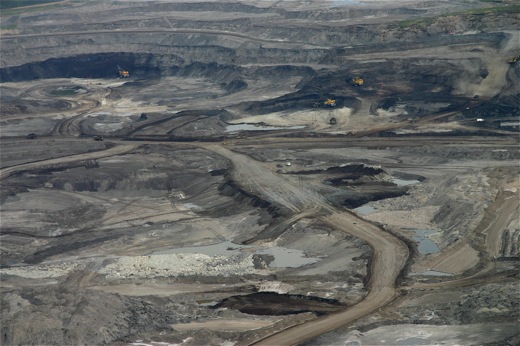Prevent A Tar Sands Disaster
By Nellis Kennedy-Howard
20 August, 2011
Yes! Magazine
Why developing the tarsands has been called "world's most destructive project."

What does it mean to live in an energy sacrifice zone? For many First Nations of Canada, it means that the land and water your families have lived on for generations is no longer safe. Nearly every major oil company in the world is participating in making the homelands of indigenous peoples unsafe by investing in the Athabascan tar sands.
In what is called by the Environmental Defense Fund the “world’s most destructive project,” an area the size of Florida is slated for various forms of mining. Locked up in sand, clay, and bitumen, tar sands oil is one of the hardest to mine and refine and is also one of the dirtiest: extracting it creates three times more greenhouse gases than conventional oil. Mining the tar sands means not only deforestation but also the creation of massive lagoons filled with toxic wastewater. These ponds are leaking 11 million liters of toxic water each day and by 2012 are expected to leak 72 million liters a day.
The project’s carbon footprint is global. Mining the tar sands requires special equipment that is manufactured in Korea, shipped across the ocean, and barged through Portland, Oregon, up the Columbia and Snake Rivers through the Nez Perce reservation and on to Idaho. The current plan is to haul it on massive trucks to northern Alberta. American highways have never seen trucks of this size, and the haul will require major modifications to roadways along the way.
Oil giant TransCanada hopes to expand the project even further by building a pipeline that will pump dirty oil from northern Alberta, across the headwaters of major rivers, and down to the Gulf of Mexico where special refineries exist to handle the lower-grade oil. The pipeline, named Keystone XL, is expected to actually raise gas prices in the states it crosses because the refined oil will have to be shipped back up from the Gulf. This rise will be the equivalent of a “$4-billion-a-year tax on oil we already get from Canada, with all the money going from American wallets and pocketbooks to oil companies,” said Jeremy Symons of the National Wildlife Federation, in testimony before the House Energy Commerce Committee.
The tar sands are a financial and environmental disaster. Keystone XL’s environmental impact statement has received massive criticism from affected tribes, environmental groups, and the Environmental Protection Agency. Symons called the pipeline “the next Deepwater Horizon disaster in the making,” according to The New York Times.
Environmental engineer John Stansbury has taken a closer look at TransCanada’s claims that, at most, 11 serious spills are likely to occur over 50 years. Stansbury’s research shows that the number is closer to 91 spills. Making matters worse, the proposal is being fast-tracked by Congress and requires President Obama to approve or deny the project by November of this year.
Celebrities and environmental leaders, such as actor Danny Glover and activist Bill McKibben, are now calling on you to help stop the destruction. A national demonstration of civil disobedience is taking place at the White House August 20 through September 3. Hundreds have committed to attend and risk arrest because the issue is so important and the voices of concerned citizens must be heard. Participants are asked to be as peaceful as possible and are required to attend a one-day training before partaking in the action. For more information, go to tarsandsaction.org.
Nellis Kennedy-Howard of the Navajo Nation wrote this article for New Livelihoods, the Fall 2011 issue of YES! Magazine. Nellis is national campaign associate for the nonprofit Honor the Earth.
The People v. the Pipeline: Time to Join In
How you can get involved in the one of the most important climate struggles happening in North America.
Interested?
What a 10-Year-Old Did for the Tar Sands
A First Nations student from British Columbia is taking on a controversial trans-Canadian pipeline project—through song.
Our Most Urgent Climate Crises (And How We Might Win Them)
Bill McKibben: In the mighty struggles beginning between climate activists and the fossil fuel industry, geography is on our side.
Worth Dying For
A video tribute to those who have sacrificed their lives to protect the environment.
YES! Magazine encourages you to make free use of this article by taking these easy steps. This work is licensed under a Creative Commons License
Comments are not moderated. Please be responsible and civil in your postings and stay within the topic discussed in the article too. If you find inappropriate comments, just Flag (Report) them and they will move into moderation que.


